Housing
Credit: Biovision-Infonet
Why should poultry be housed?
Housing is necessary to protect chicken against predators, thieves, adverse weather (rain, sun, cold winds, low night temperatures) especially during the night, and to provide shelter for egg laying and broody hens. Suitable poultry houses are important for efficient production and management. Poultry houses and shelters vary depending on availability of materials, weather and tradition. Choice of chicken housing should be based on cost, durability and usage. In organic production, outdoor access should be provided, and the hens or chicken can choose whether to be inside or outdoor.
Points to consider when selecting sites for poultry housing:
- Provision of dry, friable litter.
- Avoidance of key areas that can be patrolled by predators.
- Dark areas to be avoided except for nest boxes.
- In fixed house situations, either wire mesh or stones in areas immediately outside pop holes.
- Air quality (i.e. low ammonia levels, correct humidity, correct temperature and good ventilation) plays a crucial role in health management. The position of a house can influence ranging activity and bird health. Soil type and drainage are instrumental in determining the extent of build up of soil-borne parasites.
- Locating houses on free draining, flat, shady, south facing pasture is preferable in order to minimise the build up of internal parasites and coocidial oocysts and to ensure better retention of grass cover.
- Poultry houses should have windows on either side for ventilation. In addition a hole or ridge on the roof will ensure proper ventilation and give light making it easier to work in the house. Make sure winds ventilate the house without making chicken cold. Make sure that there are no draughts. Sitting houses should be placed at right angles to the prevailing wind slightly moderates the amount of wind entering the building through the pop holes.
- Ideally, houses should be positioned in the centre of the land area, where the hens or chicken should have access, so that a series of radiating paddocks can be created around the unit.
- Accessibility during all weather conditions is an important consideration.
- Range areas bordered by dense woodland are likely to be at greater risk from predation by foxes in particular. On the other hand, trees and bushes close to the houses provide shade, windbreaks and protect birds from flying predators. Clear grass and bushes for about 3 meters on all sides of the house to keep snakes and rats away.
- Use wire (chicken and mesh wire) on windows to avoid predators and wild birds.
- Secure premises near the family house. It is important to hear if the chickens get disturbed at night by predators or thieves.
- It can be relevant to select a site on which the poultry house faces South or East in wet regions. In a rectangular house the end walls should face East and West to ensure that only the end walls face the hot afternoon sun.
- Cheap locally available material can be very good, and natural materials like bamboo, wood, reeds, thatch grass or clay bricks will often give good protection against heat and cold nights.
- Remove the bark from the wood to reduce the parasites load. Parasite often hide beneath the bark.
- Heat, humidity, and harmful gasses may be considerably reduced through good ventilation. High temperatures may cause deaths, a drop in egg production, low shells quality and reduced weight gain. A combination of high temperatures and high humidity may cause death in young chicks.
- Placing perches and nests inside the house to safeguard chickens against various predators. Perches and nests will also help to keep chickens and eggs clean.
- Laying nests should be place in a quiet place in the house
- Make a house which is easy to clean, to protect against diseases and parasites the house must be easy to clean. It should be big
- Make the nests and perches easy to remove when cleaning
- If relevant because of disease outbreaks, houses or shelters can be sprayed with lime (or in some cases it can be necessary to use a vermicide) washed after cleaning to disinfect and kill parasite eggs from the walls and cracks. Place ashes on the floor and in the nests to discourage parasites.
- Night houses/shelters should be built on poles, well above the ground to protect the chicken from predators such as dogs, rats and snakes.
- Build your poultry house to prevent possible injury to the birds. Remove any sharp edged objects from the house.
- All chicken must have an outdoor run.
Types of housing
There are two main categories of housing organic poultry: static and mobile.
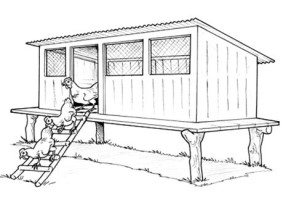
(c) PSDA 2011
Perches

Perches are important for chickens to rest on at night. The provision of perches for laying birds satisfies a natural behavioural activity. Diseases and parasites may attack poultry resting on the floor (in contact with litter). Each one-meter perch may roost five adult birds. Perches are best made of bamboo or rounded sticks and not too big or too small. Treat perches with used engine oil or kerosene to keep away parasites.
However, if badly designed, these can result in pain and injury. Perches should be arranged so as to enable birds to easily move between them and other equipment, thus reducing the risk of collisions and subsequent bruising and/or other damage. Consideration should be given to minimizing bird stress and downgrading during catching at the end of the laying period. The ability to remove perches aids this process.
Floors made of net are not acceptable for chicken, and they are harmful to the feed of the hens and chicken. See the pictures below.
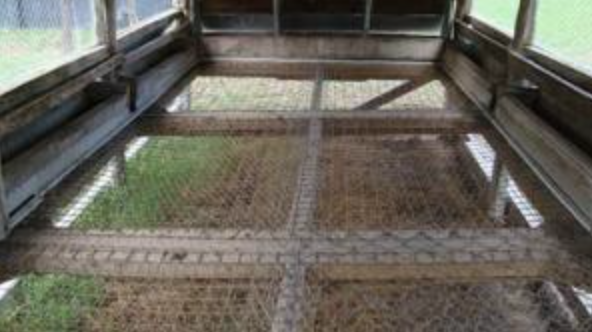
NOT acceptable housing for chicken. Floors made of net or wire mesh are not acceptable for chicken, and they are harmful to the feet of the hens and chicken.
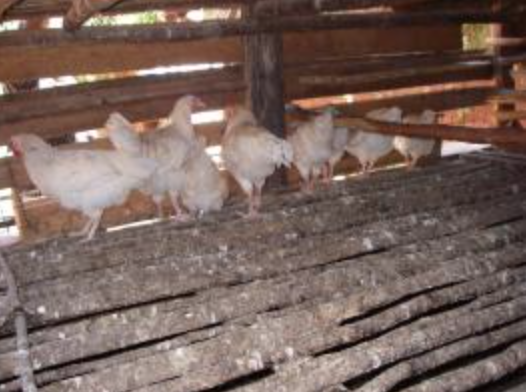
Acceptable housing for chicken with slatted floor. They must be allowed outdoor and the slatted floor should only be half of the area.
Nests
When laying nests are not provided, hens lay eggs on the ground, in tall grass or in natural shelters where they may be difficult locate. Avoid building nests on the ground or outside chicken houses. Nests outside the house expose eggs to predators and thieves. Laying nests ease egg collection and avoids eggs that are dirty and cracked. Eggs should be collected twice a daily at the same time each day (mid-morning and the evening). Removing eggs continuously is important to stop hens from going broody since broody hens stop laying.
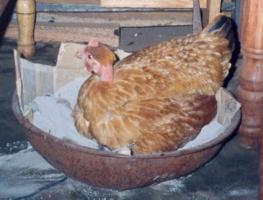
(c) A. Wachira, KARI, Kenya
To reduce the impact of excessive aggression within a flock, and to avoid floor laying and wastage, it is important that sufficient nest boxes are available. The provision of perches and of ground-level nest boxes will also encourage the use of nest boxes amongst a greater proportion of hens. It is important that nest boxes are sufficiently accessible so that they can be easily cleaned between batches.
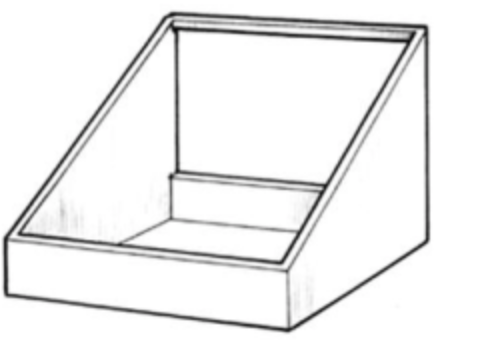
(c) Marete
Nests should be placed inside the chicken house and preferably above the ground. Provide one laying nest for every 5 hens. Brooding nests are individual nests and should be placed in quiet and dark places where eggs are easily removed. Once the hen is broody it may be necessary to remove her to an isolated place to avoid other hens disturbing her or going broody as well.
Simple nests can be made out of clay, calabashes or baskets made of local fibres, cardboard or wooden boxes. Nests should have the correct measurement for the hen to feel comfortable. An individual nest box measures 30 x 30 x 30 cm. A calabash/nest basket or nests made out of clay measure 40 x 20 x 25 cm (upper diameter x height x lower diameter).
Nests should have the correct measurement for the hen to feel comfortable. An individual nest box measures 30 x 30 x 30 cm. A calabash/nest basket or nests made out of clay measure 40 x 20 x 25 cm (upper diameter x height x lower diameter).
Three steps when preparing an individual nest
1) Ensure the pot or basket is clean and dry
2) Fill the pot or basket with sand mixed with ashes up to 1/3 full
3) Place clean, soft nesting litter material (hay or straw or wood shaving) on top up to 2/3 full.
Nesting material should be changed at least once a week. Ensure that the nest is 1/3 full with litter material to make the hen feel secure. When necessary place ‘dummy eggs’ (e.g. stone eggs) in the nests to train/attract the hens into using the nests. Mix ashes, tobacco leaves or other anti-parasitic substances with the nesting material. This will keep out most external parasites. External parasites reduce hatchability, since brooding hens spend too much time and energy leaving the nest, cleaning and scratching her body hence leaving the eggs cold.
Shelters for mother hen and chicks Upon hatching, it is important to keep the hen and chicks close together in a shelter. Shelter should protect chicks from adult poultry; feed competition with other poultry and protect against predators. Shelters should provide a stable environment for the chicks and shelter from bad weather. Place the shelter on a mat to protect against the cold. A shelter of basketwork with a top hole (diameter 20 cm) is useful, as feed and water may be changed without disturbing the chicks. It also gives the necessary ventilation. A woven mat on the floor may provide additional protection during cold weather. The mat should be cleaned daily to remove droppings and spilled/contaminated feed. Droppings may be recycled as farm manure.
Litter management
Litter management is a vital component of managing the welfare of birds as ammonia release from poor litter can lead to conditions such as breast blister, hock burn, pododermatitis and respiratory disease. Management of litter in free range systems presents problems, particularly in winter when the weather is cold and litter is likely to become wet.
Three factors have particularly important effects on litter condition:
– litter moisture,
– greasy capped litter (resulting from too much fat in the feed or feed of poor quality); and
– Nitrogen in the litter.
Chicken runs
Chicken runs are a fenced open air space of 25 m2 or more where poultry are kept and protected against predators and thieves. Runs are also used for feeding, watering, for daily flock observation and collection of eggs. The walls are 2 meters high and can be made of clay or woven mat or chicken wire. A chicken run is relatively costly but provides security to the poultry. Allow adult birds to scavenge outside the run during daytime to reduce feeding costs. Protect your vegetable garden against free running poultry
Guide to good housing for young chicken
- Use baskets for night shelter and day shelter for small chicks to reduce costs and labour involved in constructing permanent houses;
- Always use locally available materials to reduce costs;
- In permanent or semi-permanent poultry houses use slatted, raised floors to remove droppings and keep out predators;
- Always use wire netting (chicken or mesh wire) for the windows to keep out predators;
- Provide perches and nests inside the house and make them removable to facilitate cleaning;
- Ensure adequate ventilation in poultry houses without making the poultry cold;
- Provide adequate drainage in case of flooding and protect birds from the hot midday sun.
- Provide nests with clean litter which are easy to access and clean
- Always house young chicks with their mother away from adult poultry.
- Make sure that houses are easy to access and clean.
- A good housing should be spacious, well illuminated, dry and airy, easy to clean and have perches for chicken.
Housing for Hybrid layers on large farms The main types of housing systems for hybrid layers (Egg production), differ mainly in the floor types and are the following and always has an outdoor run:
- Deep litter system:
Birds are reared on a floor preferably concrete to allow easy disinfection and some litter material placed 15 cm deep. Litter materials may include wood shavings, rice husks, hay, chopped up straw, crushed maize cobs and shredded paper. Allow 3 to 4 laying hens and 12-15 broilers per square metre on deep litter floor systems - Full Slatted Floor system:
Birds are reared on a raised floor made of either wooden slats or wire mesh. Slats with s width of 1.5 cm and a height of 4 cm laid 2.5 cm apart are recommended. Wire mesh usually has netting of 2.5 cm by 7.5 cm with 3 mm thickness. Allow 10 to 12 laying birds per square

Housing for Broilers
Broilers can be kept in similar confinements as layers, but do not need the laying boxes. Organic broilers grow slower than conventional ones and must have outdoor area to run and to prevent bones to be weak. In EU, they have to be 70 days old or more before slaughter. Broilers like some sunshine, which reduces stress in the flock and helps keep the birds healthy.
Partly free range (required in organic herds, where natural behavior and life is favoured)
Both hybrid layers and broiler products improve if the chicken have access to outside exercise area, greens in the diet, sunshine and areas where they can take dust baths. Eggs from layers fed with enough greens have a deep yellow yolk, which is much preferred by the market and fetches premium prices compared to the light yellow to almost white yolks of eggs from battery hens. Broilers produce better quality meat (better texture and taste) if they have access to outdoor facilities such as sunshine, exercise, dust bath areas and green feed. They also have stronger bones and less tendency to break legs during processing.
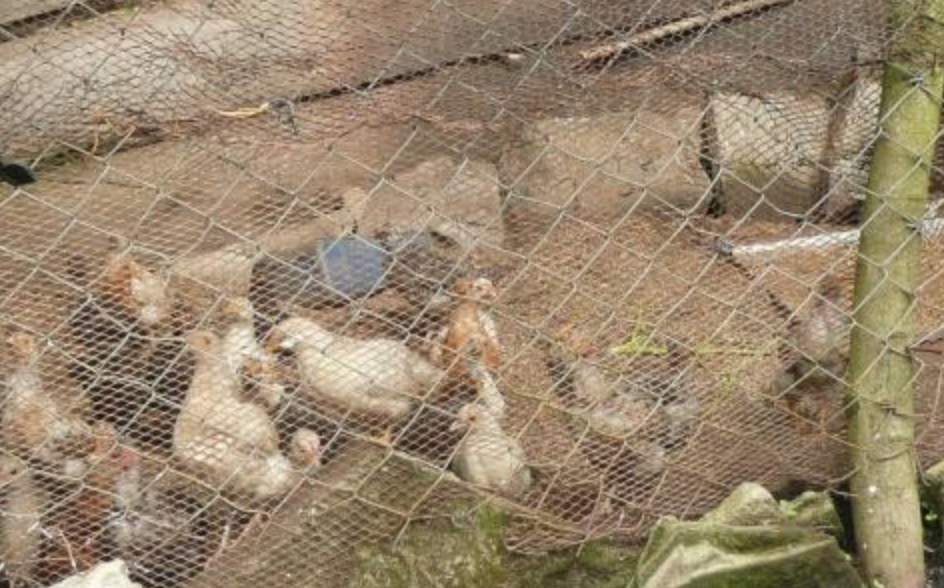
Housing for Indigenous chicken
Poultry are often allowed to scavenge for food in the local environment during day time, getting housed in the evenings. In some cases they roost in the branches of trees or in enclosed baskets in the house to protect from predators and theft. In other cases, keepers build wooden, stone or brick accommodation attached to the family dwelling house. As brick houses tend to be difficult to keep clean. They present a potential threat due to the build-up of pathogens.
In Kenya, there are several housing structures, which include:
- The dome-shaped stick basket, known in western Kenya as Lisera, Liuli or Osero, ideal for daytime housing
- The stick-built Kiduli and other standard poultry houses
Hygiene
It is important to reduce chances of infection to a minimum. Measures for preventing disease include the following;
- Keep the chicken house clean and dry at all times
- Disinfect all litter material before use
- Locate the chicken farm at least 100m away from other chicken farms
- Keep away visitors from the chicken houses.
- Control rodents and mice
- Clean drinking equipment and feeders regularly
- Clean the chicken houses thoroughly and disinfect after disposing all birds
- Remove dead birds immediately and bury them or burn them
Lighting
There should be adequate natural light in the poultry unit. The light should be enough for a person to read a newspaper at the centre of the building. Transparent roofing sheets should be fitted to improve lighting. Light in laying birds stimulates increased egg production. There should be a period of at least 8 continuous hours without artificial light at night to respect the daily rest-period of the chicken.
Ventilation
- Poultry unit should have free flow of fresh air.
- A chimney aids the flow of air from the back to the front.
- Place 0.6 m wire-mesh opening at the back, and 1.0 m opening in front of the building. In hot areas front ventilation should be made as big as 2 metres from the top. During the cold weather cover the ventilation with curtains.
Sunshine/Shade
All creatures need some sunshine. The sun helps the birds manufacture Vitamin E. Chicken must have an outdoor exercise area where they can sun themselves and take dust bath during the day. This helps keep down external parasites, reduces stress and keeps the birds more resistant to diseases.
Space
- Too many birds kept together in non-challenging and boring conditions may cannibalise/wound or even kill each other, as the stronger ones peck the weaker.
- Do not keep local breeds in confinement without free access to outdoor areas. Also hybrid chicken do better with acces to outside runs.
- Provide a space of 5 square meters per adult bird in a run system.
- When space is limited, diseases are passed more easily from one bird to another.
Bio Security
When infectious diseases are known to occur in the region there could some recursions made to avoid infections. In free range chicken hygienic measures focus on:
- Burn and bury dead birds
- Do not allow wild birds and other fowls into the poultry house or farm
- Do generally not mix birds of various ages, which come from different places
In more industrialized chicken farms with confined chicken following advises are given to avoid infections:
- Do not allow visitors or vehicles into the poultry farm unless thoroughly disinfected
- Use foot baths with disinfectant outside each poultry house
- Wear protective clothing for each house
Farmers who regularly add EM (effective microorganisms) or BM to the drinking water of chicken are reported to have very few cases of coccidiosis and other diarrhea causing pathogens. Also vinegar can be used as a water additive if signs of diarrhea appear in the flock.
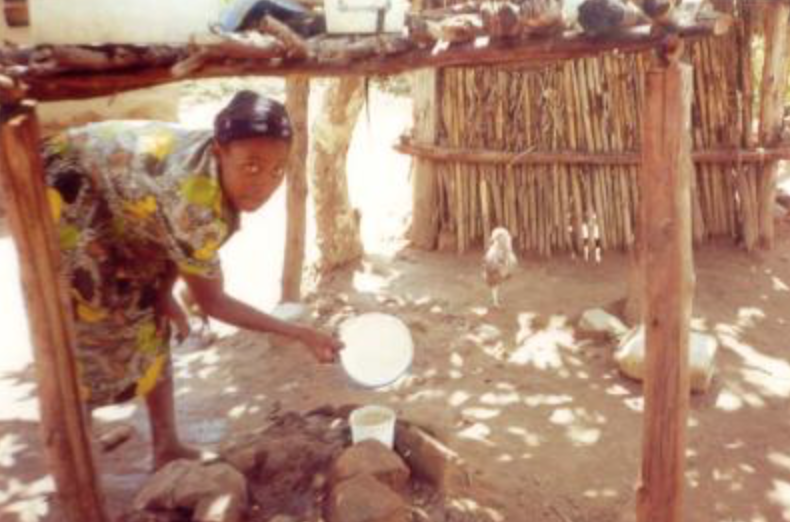
(c) Henry Ondwasy, KARI